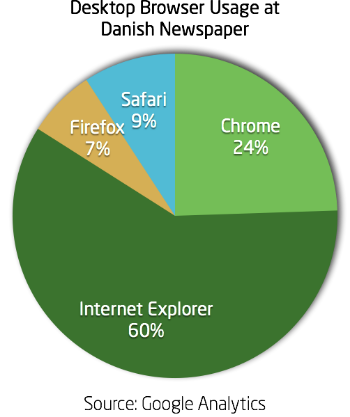App development is getting lots of attention today, and rightly so. Mobile and handheld browsing has grown explosively in recent years, and more and more users are making the switch to handheld devices. The ease and accessibility of handheld devices make them an obvious choice for reading the daily news.
However, a considerable amount of traffic is still coming from the good old desktop platform (including laptops). In fact, it is still the primary source of traffic for general web use today, making up over 62% of the total traffic. This makes the desktop platform a segment that simply must not be ignored or forgotten.
Challenge No. 1: Variety
The desktop audience is well known (and feared) for using a wide range of desktop browsers and operating systems, and this has traditionally been the source of many frustrations among web developers. Every browser has its quirks, so trying to support every browser quickly turns into an impossible task.
By gathering user base statistics, it is possible to concentrate the development effort on the most commonly used browsers. While the top browser worldwide may be Chrome, the actual user base on your specific website may have an entirely different makeup.

In Germany, Firefox rules supreme, beating both Chrome and Internet Explorer by a large margin. Scandinavians, on the other hand, like to use Chrome, but in the case of newspaper readers, they tend to favour Internet Explorer to an even larger degree.

It is clear then that picking a single browser and focusing exclusively on that is not an option in this global reality. Finding a balance between common features and adding browser-specific code paths is not easy and requires much testing and tweaking to get right.
Streamlining and all the small differences
Something that works brilliantly in one browser might just not work in another, and vice versa. The development process for desktop requires many iterations, trying out different approaches until you find a compromise that is acceptable across all the major browsers.
HTML and especially CSS standards have made it much easier over time to streamline development, with the most recent incarnation of the modern browsers having closed the gap considerably. Because each browser still typically has a number of experimental features and implementations, it can be tricky to provide a user experience that is the same across all browsers.
By using third party libraries such as JQuery, developers can avoid many of the differences between browsers. A layer on top of JavaScript handles the differences and makes sure the result is the same, regardless of the browser. JQuery has proven its worth many times and is one of the most commonly used libraries in web development today.
However, even when using third party libraries and adhering to standards, and despite targeting only the latest versions of the popular browsers, there will still be technical issues that complicate development. Even today, decades after the first browser was released, there are still subtle differences in implementation – and some that are not so subtle.
Looking forward
While all the browsers possess the ability to show simple content, the true challenge comes when pushing performance to the limit. With more advanced user interfaces approaching those of apps, demand for performance and speed has never been higher.
The future is guaranteed to bring exciting new options and improved performance. With Windows 10 and Microsoft Edge coming soon, Microsoft has a chance to reclaim the throne that Chrome has earned over the past few years.
Whether or not Firefox and Safari will become major players, we will have to wait and see. Perhaps we will even see an outsider like Opera finding a place in the hall of fame.
It all comes down to whether or not browsers can meet these ever-increasing demands and continue to give users the smooth, enjoyable performance they have come to expect.





